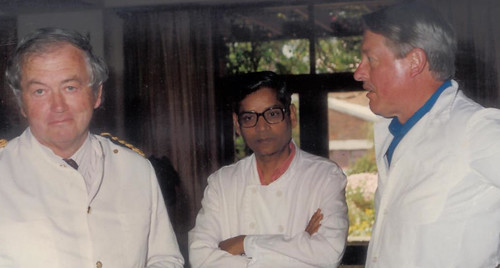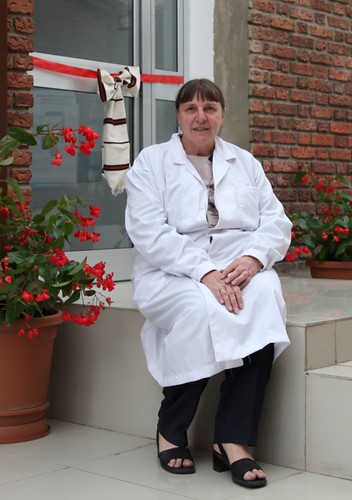Former directors general of the International Livestock Centre for Africa (ILCA), a predecessor of ILRI, John Walsh (left), who passed away in Ireland at the end of Jan 2013, and Hank Fitzhugh (right) in the 1980s; in the middle is B K Johri, ILCA personel manager (photo credit: ILRI).
John Walsh, an Irish dairy scientist and former director general of the International Livestock Centre for Africa (ILCA), headquartered in Addis Ababa, Ethiopia, and one of two predecessors of the International Livestock Research Institute (ILRI), died on 31 January 2011, peacefully in his home in County Cork, Ireland. He is survived by his wife Marie, sons Brendan and Kevin, daughters Maeve and Emer, and six grandchildren.
John Walsh was appointed director general of ILCA in December 1986, following the departure of Peter Brumby (New Zealand), ILCA’s former director general. Walsh left ILCA in July of 1993, succeeded by Hank Fitzhugh (USA) that August.
Under Walsh’s tenure, a collaborative program between ILCA and the Kenya Agricultural Research Institute (KARI) was established in August 1988 at KARI’s Mtwapa Regional Research Centre, near Mombasa, Kenya. This program went on to play a major role in an award-winning ILRI-KARI-Kenya Ministry of Livestock Development Smallholder Dairy Project, under the direction of ILCA-ILRI scientist Bill Thorpe. ILCA also at this time established strong collaboration with the Ethiopian Agricultural Research Organisation (EARO), such as in smallholder dairy at the Holleta Research Station.
In September 1989, ILCA’s Semi-Arid Zone Programme was established in Niger at the Sahelian Centre of the International Crops Research Institute for the Semi-Arid Tropics (ICRISAT). In 1991 — the year in which the Ethiopia Government was overthrown — a joint ILCA-ILRAD African Trypanotolerant Livestock Network project, which had begun in 1980, was concluded. In 1992, ILCA launched a project to help conserve Africa’s indigenous animal genetic resources, which became a major program at ILCA and then ILRI under the leadership of ILCA-ILRI scientist Ed Rege.
‘Walsh brought to ILCA a strong emphasis on strengthening national agricultural research systems (NARS) of Africa’, says Hank Fitzhugh. ‘Training African scientists and extension agents and running collaborative research networks were given high priority. Among the collaborative research networks ILCA spearheaded at this time were the Small Ruminant Research Network, the Cattle Research Network and the Feed Resources Research Network. Many consider this emphasis on NARS, acknowledged by the Third External Program and Management Review of ILCA, to be Walsh’s legacy.’
Jean Hanson, a former and long-standing ILCA-ILRI scientist who headed ILRI’s Forage Genebank, and Fitzhugh both remember John’s kind heart, especially his concern for the disadvantaged.
Jean Hanson speaks for the ILRI family in her tribute that follows.
‘John had a strong background in livestock science in Ireland and strong administrative skills. One of the first things that John did when he joined ILCA was to put in place administrative policies and guidelines to bring order into the running of the institute. He liked things to be done in a very orderly way and led by example. He would walk up to the main gate and observe the time that staff arrived to make the point that he expected them to keep the working hours and he would pick up any waste paper lying on the ground and drop it into the bin to encourage others to keep the place tidy.
‘He was very hands on and used to walk around and drop into staff offices for a chat about how the work was going and what the challenges were and if as director general he could do anything to move the work forward. He was very proud of the compound and the image of ILCA and was responsible for the purchase of a sculpture at the front entrance of ILCA, which depicts a calf being fed a special type of salt bar (‘amole chow’) by a woman, from the Art School at Addis Ababa University just before his departure in 1993.
‘He led ILCA through its period of expansion in sub-Saharan Africa and the difficult transition of power in Ethiopia in 1991. He was out of the country on official travel when things started to unfold and flew back to do what he could to ensure the safety of the staff and continued running of the research. He was very concerned about staff safety directly after the transition. He only gave me permission, for example, to go out to the field sites to pay staff and see how things were doing if I took his personal driver as my bodyguard.
‘John was very egalitarian and was deeply concerned about the rural poverty in Ethiopia. One year he asked the ILCA photographer to go out in the countryside on ‘International Christmas Day’, which is a normal working day in Ethiopia because the Orthodox Christmas falls on 7 January, to document a normal day in the life of poor livestock farmers as a contrast to the excesses on that day in many developed countries. He cared about his staff and instigated an annual thank you lunch for the housing and catering staff where senior management served them on that one day of the year.
‘John was a staunch supporter of ILCA’s Zebu Club and he and the children played tennis there. He was very attached to Ethiopia and was so excited when the Olympian distance runner Deratu Tulu won the first gold medal for Ethiopia at the Barcelona Olympics that he invited her to visit ILRI to meet our staff.
‘After he left ILCA, John returned to Ireland and was active in livestock research there for some time. He was on the organizing committee of the International Grasslands Congress that was held in Ireland in 2005.’
The ILRI family extends its condolences to John’s wife Marie and family.





